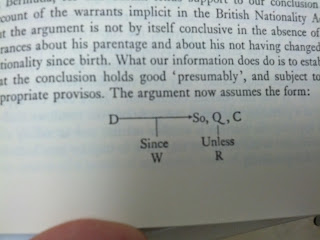By Stephen Toulmin
A few days ago, I remarked on Twitter that I was reading through The Uses of Argument, and it was like listening to a Flock of Seagulls
However—to continue the analogy—The Uses of Argument is really an album rather than a collection of songs; its chapters, although they still work as standalone essays, build on each other to develop a larger argument about language. Since Toulmin is a logician rather than a rhetorician, that larger argument is oriented toward logic and (like most logic texts) attends to levels of detail in which I am uninterested.
The argument is that we need to answer the question "what sort of a science is logic?" (p.6). And after describing several possible answers—logic as individual psychological phenomenon, logic as group sociological phenomenon, logic as technological craft, logic as mathematics (pp.3-5). He suggests that we consider a new analogy:
Logic is concerned with the soundness of the claims we make—with the solidity of the grounds we produce to support them, the firmness of the backing we provide for them—or to change the metaphor, with the sort of case we present in defence of our claims. The legal analogy implied in this last way of putting the point can for once be a real help. So let us forget about psychology, sociology, technology and mathematics, ignore the echoes of structural engineering and collage in the words 'grounds' and 'backing', and take as our model the discipline of jurisprudence. Logic (we may say) is generalised jurisprudence. ... A main task of jurisprudence is to characterise the essentials of the legal process: the procedures by which claims-at-law are put forward, disputed and determined, and the categories in terms of which this is done. Our own inquiry is a parallel one: we shall aim, in a similar way, to characterise what may be called 'the rational process,' the procedures and categories by using which claims-in-general can be argued and settled. (p.7)This jurisprudence analogy should be familiar to rhetoricians—after all, systematic rhetoric began with law—and sets the tone for the rest of the book. It also brings us to Chapter III, "The Layout of Arguments," which is the Top 10 hit I mentioned.
"An argument is like an organism," Toulmin states at the beginning of Chapter III. "It has both a gross, anatomical structure and a finer, as-it-were physiological one" (p.94). The gross structure might include introduction, background, proposition, conclusion, etc.—although Toulmin doesn't use the term, we might think of the genre of the argument, including the different "chief anatomical units" that distinguish a sermon from a proposal from a recommendation report from a Yelp review. But Toulmin is more interested in the finer structure: "within each paragraph, when one gets down to the level of individual sentences, a finer structure can be recognised, and this is the structure with which logicians have mainly concerned themselves" (p.94).
In regarding this finer structure, Toulmin contrasts two models: the mathematical and the jurisprudential. Is a formally valid argument in proper form or geometrical form? "Or does the notion of logical form somehow combine both of these aspects, so that to lay an argument out in proper form necessarily requires the adoption of a particular geometrical layout?" (p.95).
To attack the problem, Toulmin proposes an elementary distinction: between the claim (C) "or conclusion whose merits we are seeking to establish" and the data (D), or "the facts we appeal to as the foundation for the claim" (p.97). The two are connected by warrants (W), or general, hypothetical statements that bridge the two. So we have a pattern like this:
(p.99)
Data (D) are explicitly stated; warrants are generally implicit or assumed (p.100).
But an argument can be more complex, and usually is. For instance, claims are often modified by qualifiers (Q), "indicating the strength conferred by the warrant on this step," and sometimes indicate conditions of rebuttal (R), or "circumstances in which the general authority of that warrant would have to be set aside" (p.101). So the form now becomes:
(p.101)
And here's an extended example:
(p.102)
(p.104)
And here's the extended example:
(p.105)
The advantage of the Toulmin structure is that it is very generally applicable. It's also recursive: since any statement can be considered a claim, we can select one statement in the structure (say, D), treat it as disputable, and unpack it as a separate argument. (If we treat "Harry was born in Bermuda" as a claim, we might offer data: here's Harry's birth certificate. If we treat "here's Harry's birth certificate" as a claim, we might offer data for that claim: here's the signature of Harry's attending doctor and here's an affadavit by the same doctor.)
But—this is important—when I say this is an advantage of the Toulmin structure, notice that the advantage is both in terms of analyzing arguments and in producing them. Toulmin is most interested in the analysis. But what made the Toulmin structure a Top 10 hit for rhetoric and composition was that it provided a simple framework for students to think through how to compose their arguments as well.
Let me end with a few general remarks. The Toulmin structure does seem to fit well with Western rationalist argumentation patterns. For that reason, I think it has real potential as a training tool for rationalist discourse aimed at audiences in bureaucracies (e.g., the judiciary, to take Toulmin's example) and markets (e.g., expressing a value-proposition). Certainly it's made a big impact on how I analyze and teach my functionalist-oriented writing classes.
But I'm not sure to what extent the Toulmin structure is universally applicable. That is, although it provides a solid heuristic given certain assumptions, I'm not sure to what extent it applies to different cultures and forms of organization.
In any case, if you're interested in argumentation, this book is well worth your time. I've mostly reviewed the Top 10 hit, but to better understand it, you really should hear the whole album.







